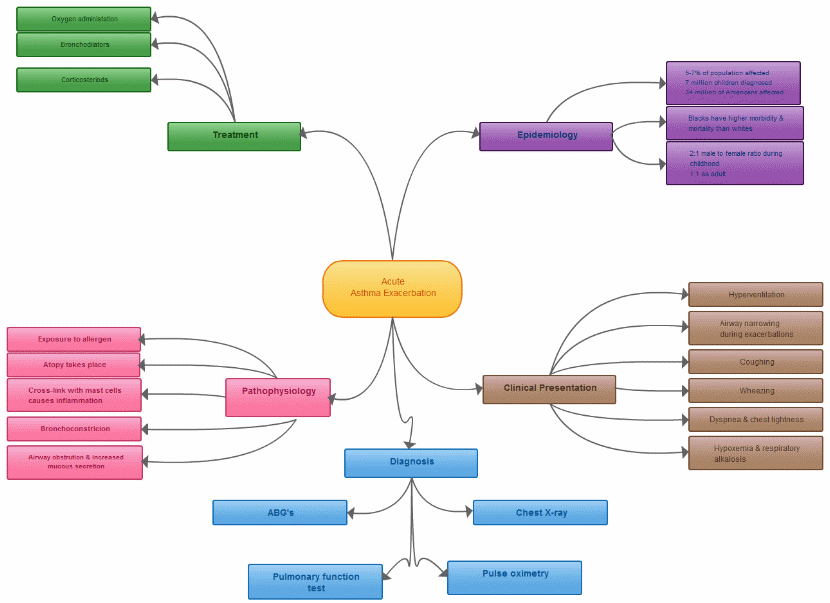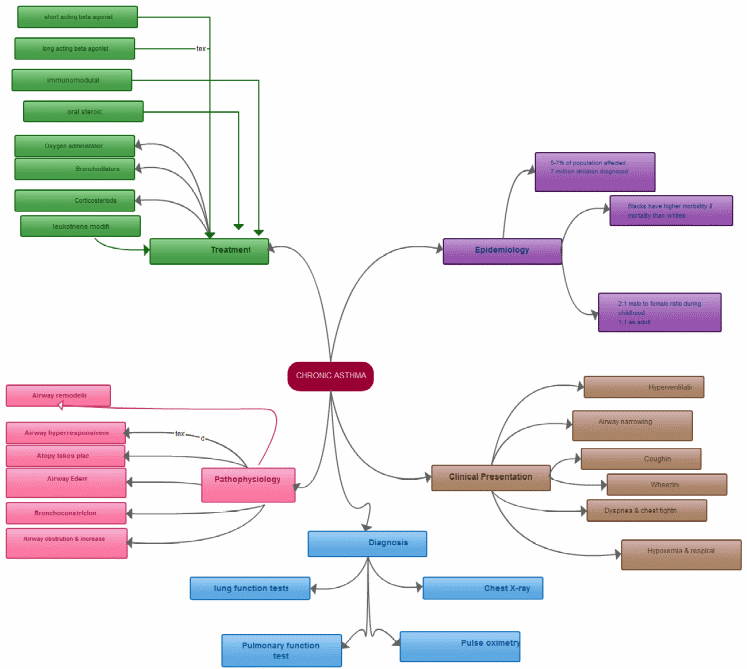Introduction
Asthma is a disorder that affects the airways. As a result, asthma patients experience cough, short breath, and chest pain. Asthma could be diagnosed using specific test examination. The features of the air passage include the bronchi, alveoli and the bronchioles. As a result, clinical manifestations of asthma include wheezing, short breath, cough, and chest blockade.
The pathophysiological mechanisms of chronic and acute asthma exacerbation
The feature of asthma obstruction includes inflammation, mucus, hypersecretion, and angiogenesis (Huether & McCance, 2012). However, inflammation is influenced by cell interaction with various mediators. The pathophysiological feature of chronic asthma includes bronchoconstriction, airway edema, airway hyperresponsiveness, and airway remodeling. The pathophysiology of chronic and acute asthma exacerbation describes the process and stages that lead to airway obstruction (Barnes, 2013).
Bronchoconstriction
The major physiological event that causes clinical symptoms is airways obstruction and interference. However, in acute asthma exacerbation the physiological even includes muscle contraction and airway obstruction. Various irritants cause the bronchial contraction. As a result, the irritants catalyzed immunoglobulin to release dependent mediators. Mediators such as tryptase and prostaglandins cause airway obstruction. However, aspirin, cold air, and allergen trigger the hyperresponsiveness of dependent mediators. In acute asthma exacerbation, stress may influence the severity of clinical symptoms.
Airway Edema
At this stage, clinical symptoms become persistent and progressive. As a result, inflammation and other features of chronic and acute asthma exacerbations are activated. The patient may experience persistent inflammation, mucus secretion, and changes in airway muscle.
Airway hyperresponsiveness
The severity of airway obstruction causes hyperresponsiveness. Thus, the degree of responsiveness is assigned to the stimuli. However, contractile responses determine the severity of acute asthma exacerbation. The change mechanism is influenced by inflammation, neuroregulation, and morphological changes.
Airway remodeling
It is a feature of asthma and acute asthma exacerbation. Airway remodeling can be reversible. Thus, changes in airway obstruction include membrane thickness, hypertrophy, and blood muscle dilation. We will discuss the process and stages of airway inflammation.
Inflammatory cells
Lymphocyte subpopulation describes the mechanism of airway inflammation in chronic and acute asthma. Thus, the displacement in helper 2 cells causes eosinophilic inflammation. However, the production of Th2 helper cells explained the development of airway obstructions. The interaction of lymphocytes and other T helper cells describes the severity of airway modeling. Another feature of airway remodeling is the mast cell. The generation of mast cell secretes bronchial mediators.
The changes in the arterial blood gas pattern
Arterial blood gas patterns influence the response to chronic and acute asthma exacerbation. As a result, the arterial blood pattern indicates the severity of the disorder. At the time of the attack, the arterial blood gas fall below 60mmHg, while the PaCO2 drops below 40mm Hg. As the attack progresses, the PaO2 and PaCO2 will drop below optimum levels. In severe cases, the PaO2 and PaCO2 would rise above optimum levels. As a result, the pH will drop below 7.40. Thus, PaO2 level will determine whether the attack is chronic or acute asthma exacerbation.
The impact of gender on the pathophysiological mechanism of chronic and acute asthma exacerbation
Hyperresponsiveness occur when airway muscles contract and narrows due to stimulus (Iannuzzi, Rybicki & Teirstein, 2009). However, the inflammatory response is the progressive stage of hyperreactive response. Risk factors contribute to the amplification of severe response.
Numerous risk factors predisposed an individual to chronic and acute asthma. However, the prevalence of the disorder has not been attributed to the risk factors that predispose an individual to asthma. The risk factors include gender, age, obesity, behavior, and ethnicity. We will discuss the impact of gender on the pathophysiology of chronic and acute asthma. The cause of asthma has not been established, however documented reports revealed that it is prevalent in adolescent male than female. The case is different in adults as women are prone to asthma attack than men.
Diagnosis and treatment of chronic and acute asthma
It is easier to diagnose adults than children. However, the patient’s family history is an important factor to consider. As a result, a doctor will conduct a physical and diagnostic test. Physical exam includes nasal condition, skin infections, nasal obstruction, and skin conditions. However, diagnostic test includes lung function tests, chest x-rays, vocal cord dysfunction test, and bronchoprovocation. As a result, gender does not affect the treatment and diagnosis of asthma. Asthma treatments are prescribed based on the severity of the attack. However, treatment procedures follow a specific procedure. The aim of treatment will either slow the inflammatory process or eliminate the risk factors that trigger the attack. Treatment interventions include quick relief, inhaled steroids, short acting beta agonist, long acting beta agonist, oral steroids, leukotriene modifiers, anticholinergic, Cromolyn sodium, immunomodulators, and methyl xanthine.
Conclusion
The major changes during an asthma attack include airway hyperresponsiveness and inflammatory response. Quick relief medication can be used to control chronic and acute asthma exacerbation (McPhee & Hammer, 2012). Thus, clinical symptoms such as wheezing, chest tightness, shortness breath, and cough can be treated with quick relief medications.
Mind map of acute asthma exacerbation

Mind map of chronic asthma

References
Barnes, C. (2013). Evidence for common genetic elements in allergic disease. J Allergy Clin Immunol. 106(3), 192–200.
Huether, E & McCance, L. (2012). Understanding pathophysiology. Mosby, USA: St.Louis Press.
Iannuzzi, C., Rybicki, A., & Teirstein, S. (2009). Sarcoidosis. The New England Journal of Medicine. 357(21), 2153-2165.
McPhee, J & Hammer, D. (2012). Pathophysiology of disease: An introduction to clinical medicine. New York, USA: McGraw-Hill Medical.